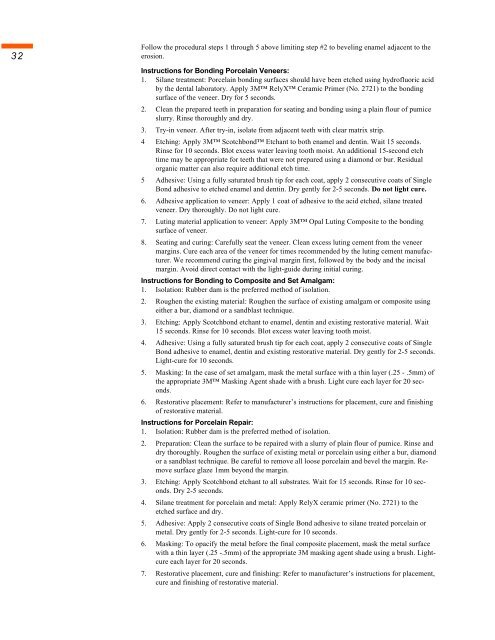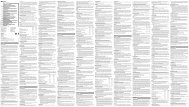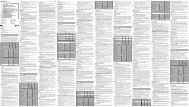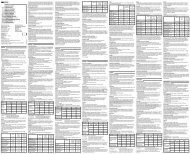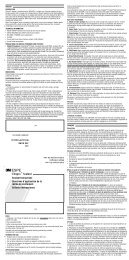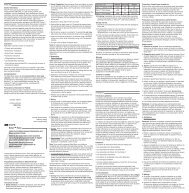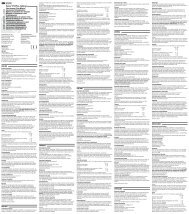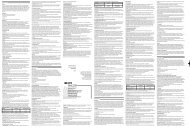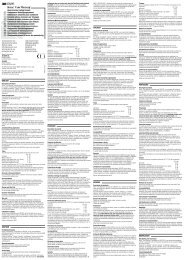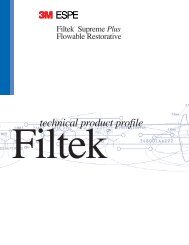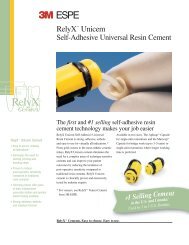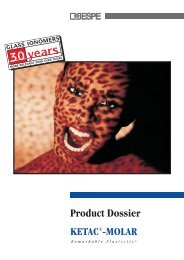RelyX⢠ARC Adhesive Resin Cement - Dale Dental
RelyX⢠ARC Adhesive Resin Cement - Dale Dental
RelyX⢠ARC Adhesive Resin Cement - Dale Dental
You also want an ePaper? Increase the reach of your titles
YUMPU automatically turns print PDFs into web optimized ePapers that Google loves.
32<br />
Follow the procedural steps 1 through 5 above limiting step #2 to beveling enamel adjacent to the<br />
erosion.<br />
Instructions for Bonding Porcelain Veneers:<br />
1. Silane treatment: Porcelain bonding surfaces should have been etched using hydrofluoric acid<br />
by the dental laboratory. Apply 3M RelyX Ceramic Primer (No. 2721) to the bonding<br />
surface of the veneer. Dry for 5 seconds.<br />
2. Clean the prepared teeth in preparation for seating and bonding using a plain flour of pumice<br />
slurry. Rinse thoroughly and dry.<br />
3. Try-in veneer. After try-in, isolate from adjacent teeth with clear matrix strip.<br />
4 Etching: Apply 3M Scotchbond Etchant to both enamel and dentin. Wait 15 seconds.<br />
Rinse for 10 seconds. Blot excess water leaving tooth moist. An additional 15-second etch<br />
time may be appropriate for teeth that were not prepared using a diamond or bur. Residual<br />
organic matter can also require additional etch time.<br />
5 <strong>Adhesive</strong>: Using a fully saturated brush tip for each coat, apply 2 consecutive coats of Single<br />
Bond adhesive to etched enamel and dentin. Dry gently for 2-5 seconds. Do not light cure.<br />
6. <strong>Adhesive</strong> application to veneer: Apply 1 coat of adhesive to the acid etched, silane treated<br />
veneer. Dry thoroughly. Do not light cure.<br />
7. Luting material application to veneer: Apply 3M Opal Luting Composite to the bonding<br />
surface of veneer.<br />
8. Seating and curing: Carefully seat the veneer. Clean excess luting cement from the veneer<br />
margins. Cure each area of the veneer for times recommended by the luting cement manufacturer.<br />
We recommend curing the gingival margin first, followed by the body and the incisal<br />
margin. Avoid direct contact with the light-guide during initial curing.<br />
Instructions for Bonding to Composite and Set Amalgam:<br />
1. Isolation: Rubber dam is the preferred method of isolation.<br />
2. Roughen the existing material: Roughen the surface of existing amalgam or composite using<br />
either a bur, diamond or a sandblast technique.<br />
3. Etching: Apply Scotchbond etchant to enamel, dentin and existing restorative material. Wait<br />
15 seconds. Rinse for 10 seconds. Blot excess water leaving tooth moist.<br />
4. <strong>Adhesive</strong>: Using a fully saturated brush tip for each coat, apply 2 consecutive coats of Single<br />
Bond adhesive to enamel, dentin and existing restorative material. Dry gently for 2-5 seconds.<br />
Light-cure for 10 seconds.<br />
5. Masking: In the case of set amalgam, mask the metal surface with a thin layer (.25 - .5mm) of<br />
the appropriate 3M Masking Agent shade with a brush. Light cure each layer for 20 seconds.<br />
6. Restorative placement: Refer to manufacturer’s instructions for placement, cure and finishing<br />
of restorative material.<br />
Instructions for Porcelain Repair:<br />
1. Isolation: Rubber dam is the preferred method of isolation.<br />
2. Preparation: Clean the surface to be repaired with a slurry of plain flour of pumice. Rinse and<br />
dry thoroughly. Roughen the surface of existing metal or porcelain using either a bur, diamond<br />
or a sandblast technique. Be careful to remove all loose porcelain and bevel the margin. Remove<br />
surface glaze 1mm beyond the margin.<br />
3. Etching: Apply Scotchbond etchant to all substrates. Wait for 15 seconds. Rinse for 10 seconds.<br />
Dry 2-5 seconds.<br />
4. Silane treatment for porcelain and metal: Apply RelyX ceramic primer (No. 2721) to the<br />
etched surface and dry.<br />
5. <strong>Adhesive</strong>: Apply 2 consecutive coats of Single Bond adhesive to silane treated porcelain or<br />
metal. Dry gently for 2-5 seconds. Light-cure for 10 seconds.<br />
6. Masking: To opacify the metal before the final composite placement, mask the metal surface<br />
with a thin layer (.25 -.5mm) of the appropriate 3M masking agent shade using a brush. Lightcure<br />
each layer for 20 seconds.<br />
7. Restorative placement, cure and finishing: Refer to manufacturer’s instructions for placement,<br />
cure and finishing of restorative material.


